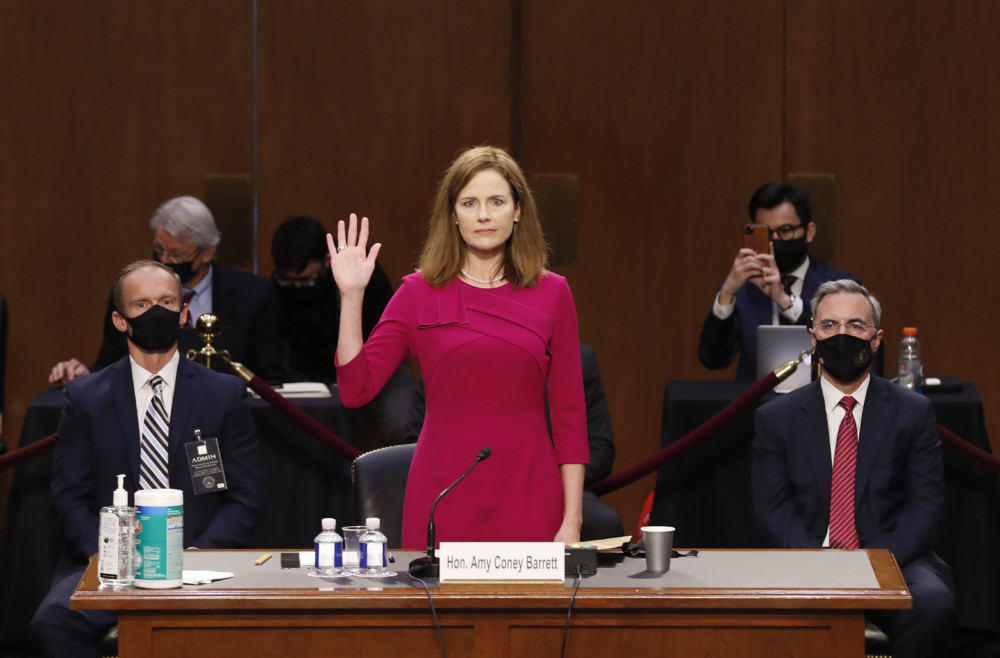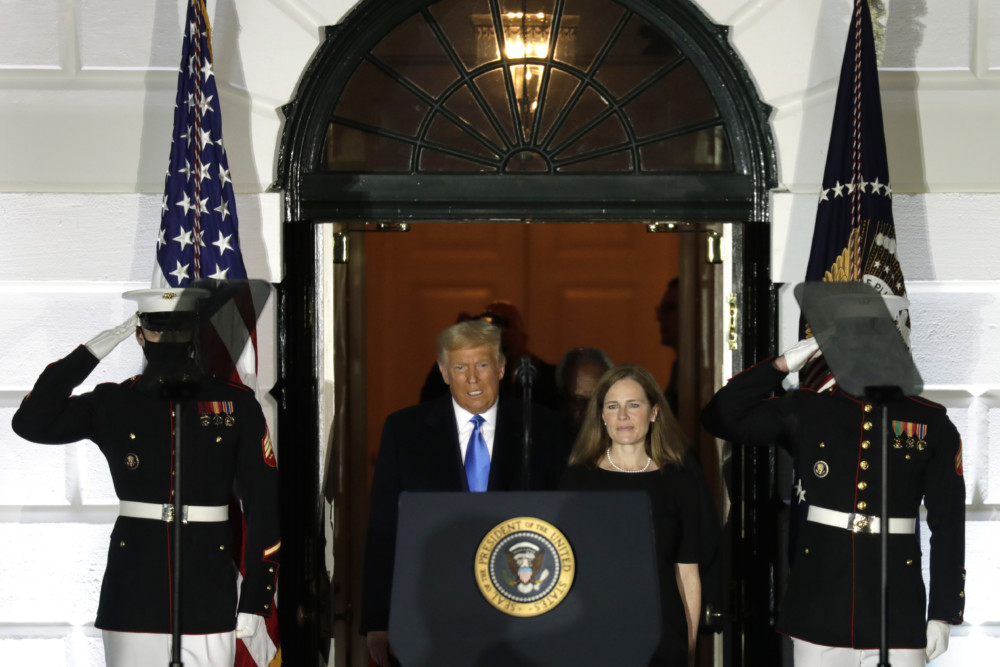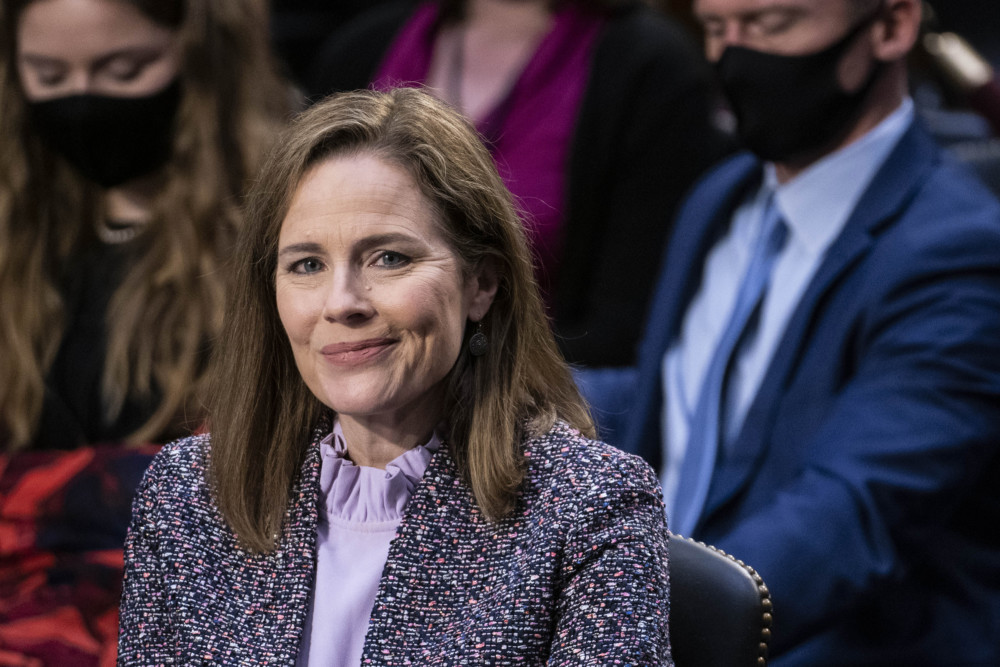By Mary Ellen McIntire
CQ-Roll Call
WWR Article Summary (tl;dr) COVID-19 became a major focus at today’s Senate Judiciary Committee hearings on Amy Coney Barrett’s nomination to the Supreme Court. Social distancing was a priority as the room was laid out differently from previous confirmation hearings and members of the public were not able to attend.
Washington
The Senate Judiciary Committee hosted not just Amy Coney Barrett on Monday, but a debate about Capitol Hill’s strategy for testing and containing COVID-19.
It all came into focus as the panel’s hearings on Barrett’s nomination to the Supreme Court got under way, particularly with the sight of one panel member, Utah Republican Mike Lee, attending Monday’s session in person less than two weeks after testing positive for the disease.
Democrats and at least one Republican panel member raised concerns about the lack of a testing regimen and the chance for someone to be infected with the virus that causes COVID-19, after Lee ended his isolation.
Sen. Thom Tillis, R-N.C., who also tested positive, and Sen. Ted Cruz, R-Texas, who is isolating because he was in contact with Lee, participated in the hearing remotely, but could attend in person later this week.
Judiciary Chairman Lindsey Graham, R-S.C, said during the hearing that the spacious room in the Hart Senate Office Building was outfitted to ensure 6 feet of separation between people and to take other precautions to limit the risk of transmitting the virus.
“I doubt if there’s any room in the country that’s been given more attention and detail to make sure it’s CDC compliant,” Graham said as he opened the hearing. “The Architect of the Capitol, working with the Attending Physician, has set up the room in a fashion that we can safely do our business.”
Still, at least one of Graham’s colleagues on the panel, Iowa Republican Joni Ernst, told reporters in Iowa over the weekend that it would be “smart” for everyone to get tested before the hearing, the Des Moines Register reported. Ernst is vice chairwoman of the Senate Republican Conference.
Although Graham insisted the room was safe, public health experts say it is difficult to eliminate the risk. Not only was the room laid out differently from previous confirmation hearings, but members of the public were not able to attend, meaning there were no interruptions from protesters, as occurred during the last Supreme Court nomination hearings for Justice Brett Kavanaugh and other high-profile hearings in recent years.
Lee, who announced his positive test on Oct. 3 after first experiencing symptoms on Sept. 30, appeared at the hearing Monday, after isolating for 10 days. He removed his face mask to make his opening remarks, which most senators and Barrett did while speaking. Lee’s office said he had followed CDC guidelines for isolating after testing positive and said earlier Monday morning on Hugh Hewitt’s radio show that he was no longer contagious.
“Based upon current CDC guidelines, you have met criteria to end COVID-19 isolation for those with mild to moderate disease,” a letter from Brian Monahan, Congress’ attending physician, said in a letter released by Lee’s office. “Specifically, it has been greater than 10 days since symptom onset, you have had no fever in absence of fever reducing medication for at least 24 hours, and your other symptoms have improved. The CDC does not recommend repeat SARS-CoV-2 PCR testing if these criteria are met.”
Amesh Adalja, a senior scholar at the Johns Hopkins University Center for Health Security and a practicing physician, said he typically discontinues self-isolation for patients who are no longer exhibiting symptoms and had a mild case of the disease after 10 days, in line with the steps Lee took. He added that he does not think a negative test is necessary for a patient to leave isolation, since oftentimes a patient will continue to shed so-called viral debris after recovering, although they are not contagious.
Georges Benjamin, the executive director of the American Public Health Association, said it appeared that Lee had followed the CDC’s guidance “by the book.” Still, he said Lee and others in the room should wear masks, even when speaking, since that can be an extra protection against aerosolization, or the virus spreading via the air.
“He is going into a relatively high-risk environment,” Benjamin said, noting that people in the room were older and some were likely to have other illnesses that could put them at higher risk for a more severe case of the virus. “If I was giving public health advice, my advice would be that everybody should wear a mask, even him, because it adds an additional layer of protection.”
He said it may have been helpful for Lee or someone returning to the committee to have a negative test result, but also acknowledged that the CDC has recently not called for that.
“I want people to be comfortable that once a person’s disease is resolved, that their disease is resolved and they’re OK to be around,” he added. “But still I think there’s a leadership function here to wear the mask.”
Anthony Fauci, the director of the National Institute for Allergy and Infectious Disease, said on CNN Monday afternoon that it would be appropriate for Lee or President Donald Trump to provide a negative test to make people feel more comfortable about returning to high-profile events like the hearing or a campaign rally, but noted it would be an added step.
Sen. Rand Paul, R-Ky., criticized Democrats for attacking Lee when he followed CDC guidance, calling Democrats and some media outlets “looney toons on all this testing stuff,” saying they weren’t acknowledging the agency’s current guidelines for isolation.
“People have to kind of get over all this stuff about testing and this and that,” he told reporters on a press call. “And they need to understand that yes, we should take precautions, but we shouldn’t be insane about it.” Paul, who tested positive for the coronavirus in March, does not wear a mask in public.
During the hearing, Sen. Kamala Harris of California, who is the Democratic Party’s vice presidential nominee, said the panel ignored a request to set up a testing regimen for the committee throughout the hearing.
“This hearing has brought together more than 50 people to sit inside a room for hours while our nation faces a deadly airborne virus,” Harris, who attended the hearing remotely, said Monday. “The decision to hold this hearing now is reckless and places facilities workers, janitorial staff, congressional aides, and Capitol Police at risk.”
Sen. Cory Booker, D-N.J., also a member of the Judiciary Committee, told reporters on Monday that he had concerns for members and other Senate workers who would be in the hearing room this week.
“We don’t have established protocols of safety or testing protocols to ensure that all who enter and exit don’t have the COVID virus,” he said. “This is clearly problematic.”
Several lawmakers have called on congressional leaders to implement widespread testing on Capitol Hill, but House Speaker Nancy Pelosi, D-Calif., and Senate Majority Leader Mitch McConnell, R-Ky., have so far resisted those requests.
Graham said that workers across the country couldn’t demand their colleagues get tested and that Republicans were running the hearing safely.
“I was tested a week ago Friday. I was negative. I feel fine,” he told reporters. “The CDC guidelines do not require quarantine or testing, in my case, and I’ll leave it up to every member.”
___
(Niels Lesniewski and Sandhya Raman contributed to this report.)
___
Distributed by Tribune Content Agency, LLC.
















































































































































































































































































































































































